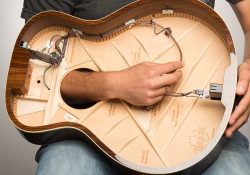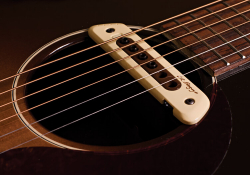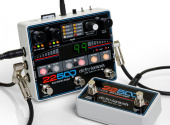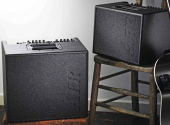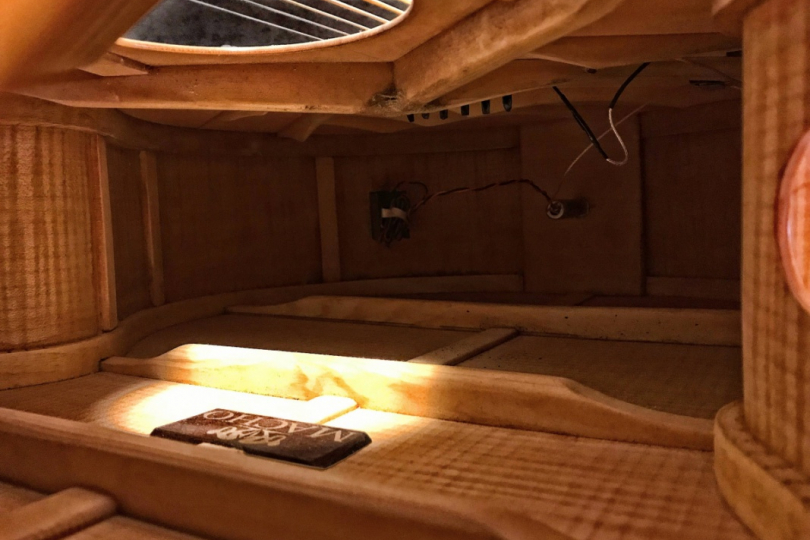
The Handbook for Electro Acoustic Guitarists, Chapter 2: Pickups
The most straightforward way of amplifying an acoustic guitar is to use a pickup, as mentioned in Chapter 1. Their choice is really wide, and each model has its strengths and weaknesses. Let's go over them a bit so that you, as an acoustic guitarist, can more easily decide which one is best for your needs and guitar-playing style.
Basically, a pickup or transducer converts vibrations into an electrical signal. Because the sound of an acoustic guitar is made up of complex vibrations and resonances of the soundboard, back and sides, strings and neck, plus the interaction with its own space (reverb), picking it up is quite a challenge. This is why many designs have been developed over the years, and thanks to the invisible hand of the market, the three most used types of pickups have emerged over the years.
UST – undersaddle transducer
Apart from UST, you also may have come across the term piezo, which is the largest part of the UST subset, but not the complete one. But regardless of the material used, it's always a thin sheet (wire, roller) inserted under the bridge saddle. Because of its simplicity and price/performance ratio, it is clearly the most used type of pickup, offered by many companies like Fishman, L.R.Baggs and Shadow.
The advantages are consistent sound, invisible installation, fast response and decent resistance to feedback, but more vigorous playing can produce an unpleasant “quack” – sterile, plastic-sounding and unnatural tone that piezo pickups produce. Anyone who has been to a concert by the legendary Tommy Emmanuel may recall that when he got really loose, no compressors could handle the "shooting sound" anymore. It's always a quid pro quo. In trying to actually amplify the intimate sound of the guitar among thousands of listeners, which is rather unrealistic, we can hardly deny the laws of physics – some compromises are bound to happen.
Magnetic pickup
This is the oldest one and is a variation of the classic electric guitar pickup. The nature of magnetism makes it clear that it only works for metal strings and can be installed very easily in the soundhole without otherwise interfering with the guitar. This is why it is often the first choice and, in addition, in the two-coil version (HB humbucker) it is the most resistant of all pickups to feedback – therefore, suitable for high volumes. The sound tends to be rounded with a slow attack, it doesn't show too much of guitar body and works well with effects but the feel can be more like an electric sound than an acoustic one. Again, it is offered by a number of acoustic companies such as Fishman, L.R.Baggs but also Dean Markley and Seymour Duncan (which is a famous manufacturer of mainly electric pickups).
SBT – soundboard transducer
Soundboard transducers are the youngest addition to the family. The ongoing boom of young guitarists (playing fingerstyle) using a variety of percussive techniques that board pickups (as the name implies, they stick to the soundboard) transmit excellently has contributed significantly to their proliferation. They are also used on instruments for which the pickups above are difficult to install (semihollow, ethnic guitars etc.) and are characterized by a warm, woody sound. They also tolerate bright playing without producing unpleasant dynamic peaks. However, they are more susceptible to feedback and the choice of their placement is crucial – otherwise, they can sound noisy or boxy. Proven companies include K&K, Schertler and Shadow.
Since “writing about music is like dancing about architecture” (© Frank Zappa), you can listen to samples of nearly 80 pickups on the aforementioned Doug Young's website and direct yourself according to your taste. Ideally, of course, you should also have three pickup systems installed in your guitar for a perfect comparison, as in the following video.
These pickups almost always include a preamp, which amplifies the signal appropriately and may also offer basic equalization or a handy integrated tuner. Gradually it turned out that the active circuit requiring a power supply (most often a 9V battery) is more advantageous on stage than the passive system. We often hear concerns about devaluing the guitar by retrofitting a pickup and preamp. The tried-and-true way is to keep expensive high-end and possibly rare guitars for studio recording, and go gigging with more suitable (durable and cheaper) instruments, because not only that the full potential of a highly dynamically responsive instrument is usually unused when amplified, but on the contrary, it can be rather a source of unpleasant complications with the acoustic nemesis – feedback.
To conclude, I would recommend relying on the proven, aforementioned companies when choosing pickups, although with a little effort, you may come across their Chinese copies looking identical and, of course, at a fraction of the price. Even their performance can be surprisingly good, but in the vast majority of cases, these (most often Fishman preamps) are accompanied by the cheapest cable (flexible) pickup, which can have a number of problems associated with it. Unlike the original pickups, it requires very careful tuning when installing and often fails despite all efforts (differences in string volume etc). You also need to be vigilant at second-hand shops, as there are always tricky fellows who offer these copies as originals. After many tests and unfortunate experiences in this segment, I have become a living example of the well-known bon mot that I am not rich enough to buy cheap things.
And next time, we'll check microphones out...
If you have found an error or typo in the article, please let us know by e-mail info@insounder.org.

